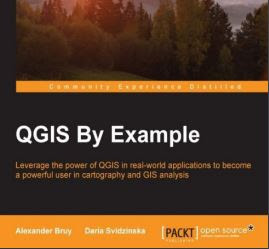Preface
Welcome to QGIS By Example. This book will help you understand the capabilities of QGIS, show you how to work with spatial data and perform the most common analyses, and bring your productivity to a new level with the Processing framework.
QGIS is a very popular and user-friendly open source desktop GIS. It provides many useful capabilities and features and their number is continuously growing. It supports a wide range of raster and vector formats, as well as databases and OGC services. It also integrates seamlessly with other FOSSGIS applications. More and more users all over the world choose QGIS as their primary GIS software.
The book will introduce QGIS 2.8.x, and show you how to properly prepare your data for comfortable work, design beautiful maps, and share them with others. It will also show you how to perform different types of analysis and interpret their results. In the final chapters, you will learn how to become more productive by automating repetitive tasks with the QGIS Processing framework, and how to extend the QGIS functionality by developing a Python plugin.
What this book covers
Chapter 1, Handling Your Data, covers the installation of QGIS, introduces its user interface, and shows you how to customize it. In this chapter, you also get to know how to load data from different sources and assemble it in a spatial database.
Chapter 2, Visualizing and Styling the Data, covers the styling of vector and raster data for displaying. Starting from the basic styling options, we go to the more advanced topics, including rule-based rendering and labeling.
Chapter 3, Presenting Data on a Print Map, shows the QGIS functionality that helps us design beautiful and easy-to-read print maps. You get to know about the print composer and learn how to use its capabilities to create great maps and map books (also known as atlases).
Chapter 4, Publishing the Map Online, explains the preparation of the QGIS project for publishing on the cloud service. This includes creating an account in the QGIS Cloud service, adjusting the project settings, uploading data, and publishing the project.
Chapter 5, Answering Questions with Density Analysis, covers techniques useful when working with large and dense point datasets. In this chapter, you learn how to create raster heat maps from point data, and how to use them to detect the hottest regions and examine spatial distribution patterns. You also get to know another technique called binning, which is an alternative approach to heat maps.
Chapter 6, Answering Questions with Visibility Analysis, demonstrates the techniques and tools used for visibility analysis. You get to know which data is necessary for visibility analysis and how to prepare it to get precise and meaningful results. You also learn how to compute viewsheds and present final results in 3D format.
Chapter 7, Answering Questions with Suitability Analysis, covers approaches and techniques used in suitability analysis. We start by interpreting spatial relationships between different objects, and you learn how to express them in the GIS language. Then you get to know how to perform suitability analysis using raster data. Finally, you learn how to interpret the results of the analysis.
Chapter 8, Automating Analysis with Processing Models, teaches you the functionality of the Processing Graphical Modeler. We start with a general overview of the Graphical Modeler. Then we go through the process of model creation, from the very beginning to the final result—a ready-to-use model.
Chapter 9, Automating Analysis with Processing Scripts, covers scripting with the QGIS Processing framework. We start from basic topics, such as using existing Processing algorithms from the QGIS Python Console. Then we see how to create our own Processing scripts with the required functionality.
Chapter 10, Developing a Python Plugin – Select by Radius, contains the topics required to develop your own Python plugin for QGIS. We start with the basic plugin template, then extend it, and finally explain how to design a plugin GUI with Qt Designer. Also, you get to know how to prepare your plugin for publishing.
What you need for this book
You will need the following software to follow all the examples in this book:
QGIS 2.8.0 or any later version
Python 2.7.6 (usually installed with QGIS under Windows or the version available in your system under Unix-like OS)
Qt and PyQt developer tools
All of this software can be freely downloaded and works under Linux, Mac OS X, and Windows
Download Here




No comments:
Post a Comment